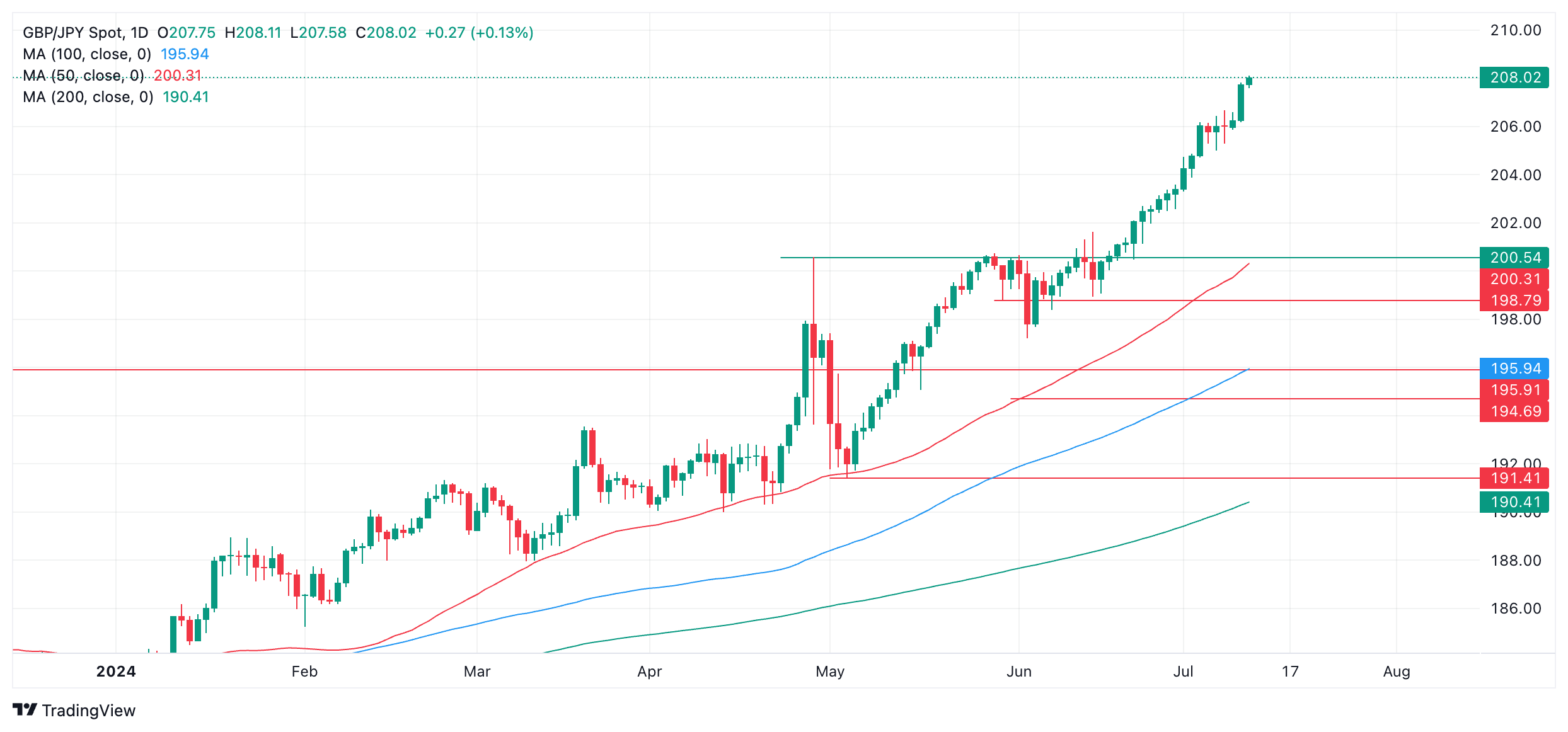- GBP/JPY rises to a new high above 208 following the release of better-than-expected UK GDP data, supporting the GBP.
- The data could prompt the BoE to take a more cautious approach to cutting interest rates, supporting the GBP.
- Japanese PPI inflation data rose sharply in June, but the BoJ is still not expected to aggressively raise rates, weighing on the JPY.
GBP/JPY hit a fresh 16-year high of 208.11 on Thursday, boosted by an appreciation in the British Pound (GBP) following the release of better-than-expected UK Gross Domestic Product (GDP) data for May.
GBP/JPY daily chart

The UK economy grew at a 0.4% monthly pace in May, higher than economists’ consensus estimates of 0.2% and 0.0% in April, according to data from the Office for National Statistics (ONS) released on Thursday.
“Many retailers and wholesalers had a good month, both recovering from a weak April. Construction grew at its fastest pace in almost a year after a recent weakness, with housebuilding and infrastructure projects boosting the industry,” said Liz McKeown, Director of Economic Statistics at the ONS.
Stronger growth data for May suggests UK second-quarter GDP growth could come in at 0.7% quarter-on-quarter, which is higher than the Bank of England (BoE) forecast of 0.5%, according to Capital Economics.
“At the margin, this may mean that the Bank (BoE) does not need to rush into cutting interest rates. We still think the Bank will cut interest rates from 5.25% to 5.00% at the next policy meeting in August, although the timing of the first cut will be heavily influenced by June inflation data and May labour market data due next week,” says Ashley Webb, UK Economist at Capital Economics.
Although still unlikely, a delay in the timing of the BoE’s first rate cut would lead to a stronger British Pound. The BoE is more likely to cut interest rates at a slower pace. This would also support the GBP, however, as higher interest rates are positive for currencies as they attract higher foreign capital inflows. It would also likely push GBP/JPY higher. That said, expectations remain high that the BoE will take the plunge and cut rates in August.
“We believe it is a fait accompli (rate cut in August) as there is simply no reason to wait until September 19. Inflation is already at the 2% target, while economic data has clearly softened in recent months,” said Dr Win Thin, Global Head of Markets Strategy at Brown Brothers Harriman (BBH).
GBP/JPY upside limited by high Japanese inflation
GBP/JPY’s upside may be limited, however, following Japan’s recent higher-than-expected Producer Price Index (PPI) data. The PPI measures “factory-gate price” inflation, which is often a precursor to inflation in the broader economy. The PPI in June came in at 2.9% YoY, beating the previous month’s 2.6% YoY reading and in line with consensus expectations. It was the fifth consecutive month of increases for the gauge, the 41st consecutive month of PPI inflation, and the highest reading since August 2023.
Despite the higher inflation data, the Bank of Japan (BoJ) is not yet expected to begin an aggressive tightening cycle where it raises interest rates meeting after meeting. Rather, it is only expected to make 0.35% of interest rate increases over the next 12 months, according to BBH, so “upward pressure” on Yen pairs is likely to persist.
GBP/JPY faces an additional risk of “stealth intervention” by Japanese authorities to prop up the Japanese Yen (JPY), according to Sagar Dua, Editor at FXStreet. In late April and early May 2024, the Bank of Japan (BoJ) carried out direct market interventions to prop up the Yen when it was at lower levels. An overly weak Yen is seen as a risk to the financial stability of importers and encourages the “wrong kind” of inflation in the economy, according to Japanese policymakers and currency watchdogs.
Source: Fx Street
I am Joshua Winder, a senior-level journalist and editor at World Stock Market. I specialize in covering news related to the stock market and economic trends. With more than 8 years of experience in this field, I have become an expert in financial reporting.







